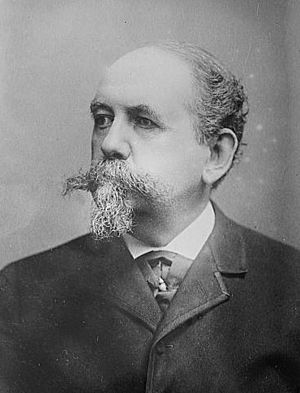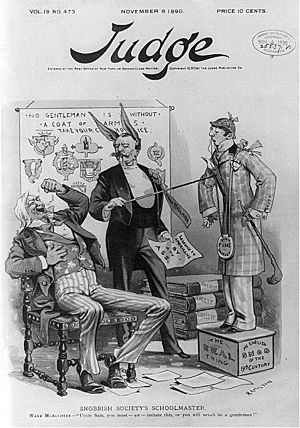Ward McAllister facts for kids
Quick facts for kids
Ward McAllister
|
|
|---|---|
 |
|
| Born |
Samuel Ward McAllister
December 28, 1827 |
| Died | January 31, 1895 (aged 67) New York City, New York, U.S.
|
| Spouse(s) |
Sarah Taintor Gibbons
(m. 1853) |
| Children | 3 |
| Parent(s) | Matthew Hall McAllister Louisa Charlotte Cutler |
| Relatives | Samuel Ward (uncle) Julia Ward Howe (cousin) Samuel Cutler Ward (cousin) Benjamin Clark Cutler (grandfather) |
Samuel Ward McAllister (born December 28, 1827 – died January 31, 1895) was a very important person in New York society during the Gilded Age. This was a time in the late 1800s when some Americans became very rich. McAllister was seen as the expert on who belonged to the most important families in New York. He created a famous list called "the Four Hundred" which named these top families. However, some people who were not on his list questioned his choices.
Contents
Early Life of Ward McAllister
Samuel Ward McAllister was born in Savannah, Georgia. His family was well-known and his father, Matthew Hall McAllister, was a judge. His mother was Louisa Charlotte McAllister.
Through his mother's side of the family, he was a cousin to famous people like Julia Ward Howe. She wrote "The Battle Hymn of the Republic."
In 1850, McAllister traveled to California with his father. This was during the exciting time of the Gold Rush. There, he became a partner in a law firm.
New York's High Society

After he got married in 1853, McAllister bought a farm. He then spent three years traveling around Europe. He visited famous cities and resorts, watching how wealthy Americans and important noble families behaved.
He returned to New York in 1858 with his wife and two children. Using his wife's money and his own connections, McAllister wanted to become a leader in New York's high society. He especially wanted to be recognized by the "Ton", which was his word for the very best of society.
McAllister's list of important families included many new rich people. It also included his friends from the South who wanted a fresh start after the American Civil War. He called his main supporter, Mrs. Caroline Astor, his "Mystic Rose."
McAllister also helped make Newport, Rhode Island, a popular summer spot. It became a favorite place for rich people who loved to have fun and show off their status. He was very good at planning parties and picnics, which made him popular in society.
McAllister tried to keep out many new rich people from the Midwest. These people were moving to New York and wanted to be part of high society. In 1893, he wrote that if Chicago party hosts wanted to be taken seriously, they should hire French chefs. He also said they should not "frappé their wine too much." The Chicago Journal joked back, saying the mayor would chill his wine just right.
McAllister's popularity began to fall when he published his book, Society as I Have Found It, in 1890. This book, and his desire for media attention, did not please the old, private wealthy families. Millionaires at that time were like today's movie stars, and they valued their privacy.
The Famous 'Four Hundred' List
McAllister created the phrase "The Four Hundred." He said there were "only 400 people in fashionable New York Society." He believed these were the only people who truly mattered in New York. He said they were the only ones who felt comfortable in fancy ballrooms.
Many people thought this number was the exact capacity of Mrs. William Backhouse Astor Jr.'s ballroom. Her grand parties were held at the Astor mansion.
On February 16, 1892, McAllister published the official list of "The Four Hundred" in The New York Times. Later, the writer O. Henry wrote a book called The Four Million. This title was a response to McAllister's list. O. Henry believed that every person in New York was important.
The Society of Patriarchs
In 1872, McAllister started a group called the "Society of Patriarchs." This group had 25 gentlemen from New York's high society. These men were seen as "representative men of worth, respectability, and responsibility."
Starting in 1885, the Patriarchs held a special party each year called the Patriarchs Ball. Each member could invite four ladies and five gentlemen. This helped decide who was considered fit for society. The first ball was held at Delmonico's. These balls were very hard to get into and received a lot of news coverage. The Patriarchs Ball inspired similar events in other cities.
The Society of Patriarchs ended in 1897, two years after McAllister died. This was because people lost interest in the group.
Ward McAllister's Family Life
On March 15, 1853, Ward McAllister married Sarah Taintor Gibbons (1829–1909). She was from Georgia and lived in Madison, New Jersey. Her grandfather was Thomas Gibbons, a politician and steamboat owner. Her father built the Gibbons Mansion in Madison, New Jersey. This mansion later became part of Drew University.
Ward and Sarah had three children:
- Louise Ward McAllister (1854–1923)
- Ward McAllister Jr. (1855–1908), who became a lawyer and a judge in Alaska.
- Heyward Hall McAllister (1859–1925)
Death and Legacy
Ward McAllister died in January 1895 while eating alone at the Union Club in New York. He was not very popular at the time because of what he had written.
His funeral was held on February 5, 1895. Many important people from society attended, including Cornelius Vanderbilt II. McAllister is buried at Green-Wood Cemetery in Brooklyn, New York.
In Popular Culture
Ward McAllister is played by actor Nathan Lane in the American TV show The Gilded Age.

